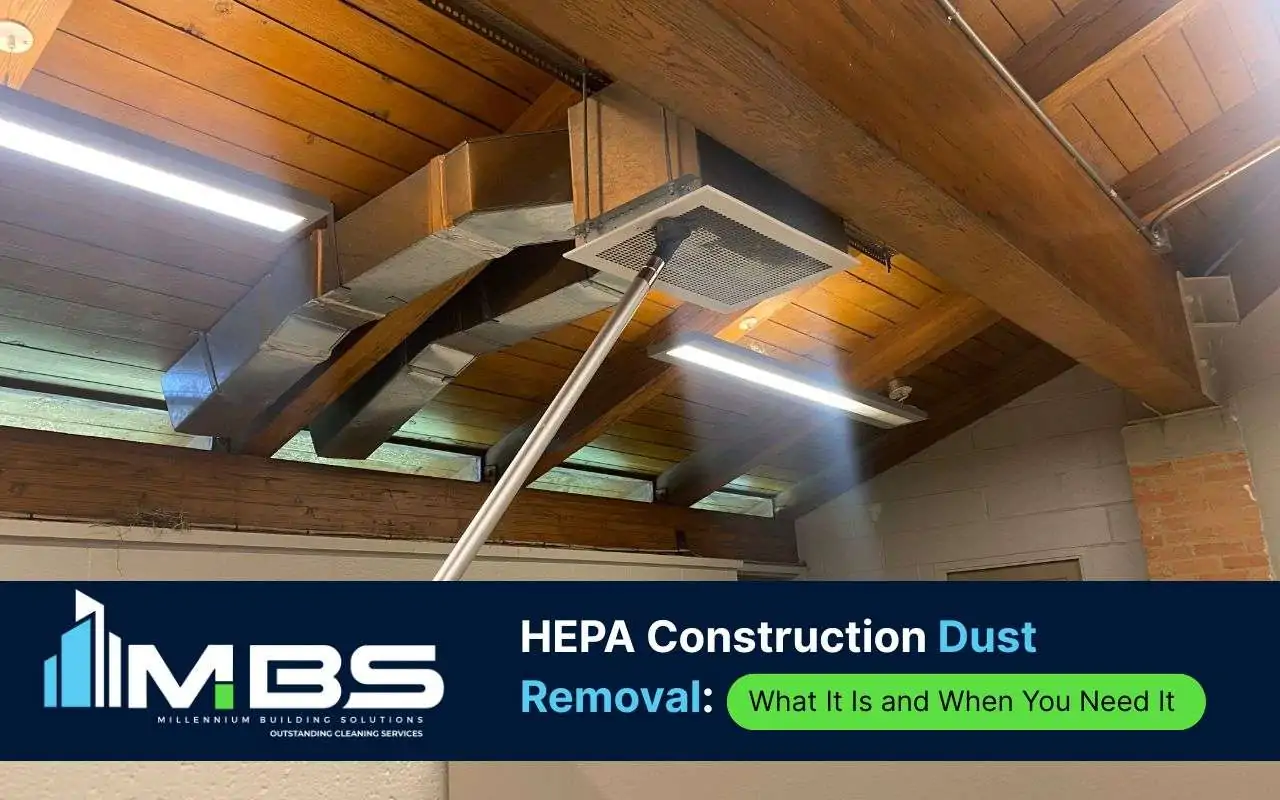
In the bustling world of construction, a silent menace hides within the fine dust left behind after each project. These tiny particles can harm health and damage finished surfaces. To combat this invisible threat, professionals rely on HEPA construction dust removal. This specialized process efficiently eliminates fine dust and ensures a safer, cleaner environment. As projects evolve and buildings take shape, controlling dust becomes vital for maintaining indoor air quality and protecting the final results.
Dust often settles in hidden spaces, clinging to every surface and circulating through the air. It poses risks to both respiratory health and structural integrity. That is why combining top-down cleaning methods with negative air containment creates a strong defense against contamination. Together, these techniques and advanced filtration systems preserve cleanliness and extend the life of your construction work. In this article, we’ll explore how HEPA construction dust removal works, why it matters, and when you should call the experts.
Understanding HEPA Filtration Systems in Construction
High-Efficiency Particulate Air filters are designed to trap 99.97% of particles as small as 0.3 microns. In construction, they are used in air scrubbers, vacuums, and portable units to remove fine dust from air and surfaces. HEPA construction dust removal relies on layers of tightly woven fibers that block even microscopic debris like silica or drywall dust. As a result, workers breathe cleaner air, and finishes remain intact throughout the process.
- Select properly rated and sealed equipment for optimal results.
- Inspect filters regularly to prevent leaks and maintain performance.
- Combine filtration with negative air containment and top-down cleaning for maximum efficiency.
Whether during demolition, sanding, or final cleanup, HEPA filtration ensures superior air quality and minimizes the spread of contaminants.
Importance of Post-Construction Dust Removal
Once structural work concludes, invisible layers of dust often remain on floors, walls, and duct systems. Without proper removal, this residue can stain finishes, block ventilation, and degrade indoor air quality. Implementing HEPA construction dust removal during this phase ensures every corner is thoroughly cleaned, protecting both aesthetics and air purity.
- Preserve warranties and maintain the value of completed properties.
- Prevent dust from damaging appliances, electronics, and HVAC systems.
- Reduce long-term cleaning and maintenance costs.
Moreover, exposure to construction dust can cause asthma, allergic reactions, and even silicosis. By choosing professional HEPA construction dust removal, you protect your team and ensure compliance with safety standards.
Risks Associated with Fine Dust in Construction Environments
Fine dust particles can cause irritation, respiratory distress, and reduced visibility on job sites. Over time, exposure increases the risk of chronic lung conditions. Beyond health effects, these particles infiltrate HVAC systems and delicate machinery, leading to costly repairs. Recognizing these hazards highlights why timely HEPA construction dust removal is crucial for both safety and operational integrity.
Top-Down Cleaning Techniques for Effective Dust Removal
Top-down cleaning ensures dust is removed in a logical order, preventing recontamination. Begin at the ceiling and move downward until reaching the floors. When paired with HEPA vacuums and microfiber materials, this method captures rather than spreads dust throughout the site.
- Start with overhead beams, fixtures, and vents.
- Continue with walls, ledges, and furnishings.
- Finish by cleaning and vacuuming the floors last.
By incorporating top-down cleaning into your routine, HEPA construction dust removal becomes more precise and efficient.
Negative Air Containment: A Key Strategy in Dust Management
Negative air containment creates a pressure barrier that draws contaminated air inward and prevents it from escaping into other areas. Portable air scrubbers or exhaust systems channel dust outdoors, keeping occupied spaces free from pollutants. This technique works hand in hand with HEPA construction dust removal to confine and eliminate airborne contaminants effectively.
When to Utilize HEPA Construction Dust Removal Services
Engaging professional services becomes essential when a project generates excessive fine dust that traditional cleaning cannot control. For instance, during drywall sanding, tile cutting, or concrete grinding, specialized teams ensure complete dust extraction. Likewise, facilities with sensitive equipment or people prone to allergies benefit from early intervention. If you need expert assistance, visit our services page to learn how our trained technicians can help maintain clean air quality throughout your site.
Benefits of Implementing HEPA Filtration in Construction Projects
HEPA filtration enhances air quality by capturing nearly all airborne particles. Cleaner environments reduce allergic reactions and respiratory discomfort. Furthermore, they minimize downtime caused by clogged filters and extend the life of delicate instruments. Clients appreciate visible dust control, viewing it as a mark of professionalism and care. Whether in hospitals, laboratories, or homes, consistent HEPA construction dust removal contributes to safer, healthier spaces.
Practical Steps for Maintaining a Dust-Free Environment
Maintaining a clean site requires ongoing effort and proper training. Regularly inspect and replace filters, seal work areas, and schedule systematic cleanings. Combining top-down techniques with negative air containment delivers sustainable results over time.
To keep your project spotless and safe, consider reaching out through our contact page to schedule a consultation with our experts.
Frequently Asked Questions
What is included in a HEPA construction dust removal process?
It involves HEPA-filtered vacuums, top-down cleaning, and containment strategies that remove and prevent fine dust buildup.
How does HEPA construction dust removal improve air quality?
It traps over 99% of airborne particles, reducing allergens, contaminants, and harmful residues from construction activities.
When should I schedule HEPA construction dust removal?
Schedule it during final cleanup or whenever significant dust accumulates after heavy renovation or structural work.
Can HEPA filtration protect sensitive equipment?
Yes, it prevents dust from infiltrating mechanical systems, ensuring stable performance and reduced maintenance needs.
Is HEPA construction dust removal necessary for small projects?
Even small renovations produce fine dust that lingers in the air. Using HEPA methods guarantees a healthier space.
Ensuring Health and Success with HEPA Construction Dust Removal
Effective dust control is more than a finishing touch—it safeguards health, prolongs material life, and enhances comfort. Incorporating HEPA construction dust removal along with top-down cleaning and air containment ensures long-term cleanliness and safety. Through proactive planning and professional assistance, you can deliver spaces that look impeccable and promote well-being for everyone who enters them.
